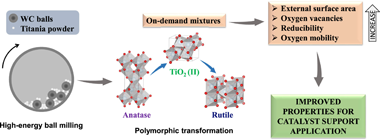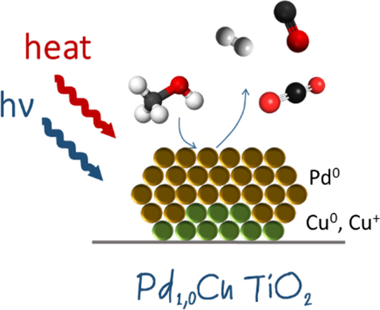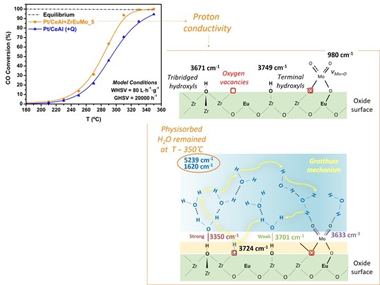Scientific Papers in SCI
2020
2020
Materiales Nanoestructurados y Microestructura
Tailoring materials by high-energy ball milling: TiO2 mixtures for catalyst support application
Rinaudo, MG; Beltran, AM; Fernandez, MA; Cadus, LE; Morales, MRMaterials Today Chemistry, 17 (2020) 100340
Show abstract ▽

We carried out a rational design of catalyst supports by high-energy ball milling. Tailored mixtures of TiO2 crystalline phases were obtained using rotational speed and milling time as variable parameters. Polymorphic transformation from anatase to rutile through high-pressure TiO2 (II) as intermediate was confirmed by X-ray Diffraction (XRD), Raman Spectroscopy and Transmission Electron Microscopy (TEM). Also, starting material doubled its specific surface area due to particle fragmentation, as confirmed by surface area of Brunauer-Emmet-Teller (S-BET) and Scanning Electron Microscopy (SEM). Defects introduced during milling process generated oxygen vacancies in the surface and bulk of supports, as evidenced by X-ray Photoelectron Spectroscopy (XPS) and Electron Paramagnetic Resonance (EPR). Furthermore, longer milling time increased reducibility and oxygen mobility of supports, as observed by H-2 Temperature Programmed Reduction (H-2-TPR) and O-2 Temperature Programmed Desorption (O-2-TPD). Phase composition remained unchanged even under extreme conditions, highlighting the stability of unusual TiO2 (II) phase. Properties achieved in present materials could benefit metal-support interactions and play a major role in supported catalysts.
September, 2020 | DOI: 10.1016/j.mtchem.2020.100340
Materiales de Diseño para la Energía y Medioambiente
An electrochemical evaluation of nitrogen-doped carbons as anodes for lithium ion batteries
Gomez-Martin, A; Martinez-Fernandez, J; Ruttert, M; Winter, M; Placke, T; Ramirez-Rico, JCarbon, 164 (2020) 261-271
Show abstract ▽

New anode materials beyond graphite are needed to improve the performance of lithium ion batteries (LIBs). Chemical doping with nitrogen has emerged as a simple strategy for enhancing lithium storage in carbon-based anodes. While specific capacity and rate capability are improved by doping, little is known about other key electrochemical properties relevant to practical applications. This work presents a systematic evaluation of electrochemical characteristics of nitrogen-doped carbons derived from a biomass source and urea powder as anodes in LIB half- and full-cells. Results show that doped carbons suffer from a continuous loss in capacity upon cycling that is more severe for higher nitrogen contents. Nitrogen negatively impacts the voltage and energy efficiencies at low charge/discharge current densities. However, as the charge/discharge rate increases, the voltage and energy efficiencies of the doped carbons outperform the non-doped ones. We provide insights towards a fundamental understanding of the requirements needed for practical applications and reveal drawbacks to be overcome by novel doped carbon-based anode materials in LIB applications. With this work, we also want to encourage other researchers to evaluate electrochemical characteristics besides capacity and cycling stability which are mandatory to assess the practicality of novel materials.
August, 2020 | DOI: 10.1016/j.carbon.2020.04.003
Propiedades mecánicas, modelización y caracterización de cerámicos avanzados
Disclination dipoles are the Holy Grail for high temperature superplasticity in ceramics
Moshtaghioun, BM; Bejarano-Palma, JA; Garcia, DGScripta Materialia, 185 (2020) 21-24
Show abstract ▽

A model for high-temperature plasticity of polycrystals controlled by disclination dipoles is proposed that predict a parabolic dependence of the strain rate versus the applied stress. The presence of a precise stationary disclination density explains the origin of plasticity without microstructural invariance, commonly known as superplasticity. The disclination mechanism is universal, although other processes, such as dislocation glide, are superposed to this one in many systems such as metals or metallic alloys. While, in ceramics it is likely to be the only operative mechanism. Activation of disclination dipoles is a necessary condition for plasticity and sufficient one for superplastic yielding.
August, 2020 | DOI: 10.1016/j.scriptamat.2020.03.049
Materiales y Procesos Catalíticos de Interés Ambiental y Energético
Thermo-Photocatalytic Methanol Reforming for Hydrogen Production over a CuPd-TiO2 Catalyst
Lopez-Martin, A; Platero, F; Caballero, A; Colon, GChemPhotoChem, 4 (2020) 630-637
Show abstract ▽

A bimetallic CuPd/TiO2 system has been prepared by a two-step synthesis and was used for a methanol steam photoreforming reaction. By sequential deposition, palladium is deposited over copper nanoclusters through a galvanic replacement process. Hydrogen production by steam reforming from methanol was achieved by both thermo-photocatalytic and photocatalytic processes. It appears that H-2 production on the bimetallic system is notably higher than the Pd monometallic reference. Moreover this difference in the catalytic performance could be related to the higher CO evolution observed for the monometallic Pd-1.0 TiO2 system which is partially inhibited in the bimetallic catalyst. In addition, an important thermal effect can be envisaged in all cases. Nevertheless, this improved effect in the thermo-photocatalytic process is accompanied by a remarkable CO evolution and SMSI effect (important strong metal-support interactions) that hindered the efficiency as temperature increases. On this basis, optimal operational conditions for H-2 production are obtained for thermo-photocatalytic reforming at 100 degrees C, for which the synergetic effect is higher with lower CO production (H-2/CO=4)
August, 2020 | DOI: 10.1002/cptc.202000010
Química de Superficies y Catálisis
Elucidation of Water Promoter Effect of Proton Conductor in WGS Reaction over Pt-Based Catalyst: An Operando DRIFTS Study
Jurado, L; Garcia-Moncada, N; Bobadilla, LF; Romero-Sarria, F; Odriozola, JACatalysts, 10 (2020) 841
Show abstract ▽

A conventional Pt/CeO2/Al(2)O(3)catalyst physically mixed with an ionic conductor (Mo- or Eu-doped ZrO2) was tested at high space velocity (20,000 h(-1)and 80 L h(-1)g(cat)(-1)) under model conditions (only with CO and H2O) and industrial conditions, with a realistic feed. The promoted system with the ionic conductor physically mixed showed better catalytic activity associated with better water dissociation and mobility, considered as a rate-determining step. The water activation was assessed by operando diffuse reflectance infrared fourier transformed spectroscopy (DRIFTS) studies under reaction conditions and the Mo-containing ionic conductor exhibited the presence of both dissociated (3724 cm(-1)) and physisorbed (5239 cm(-1)) water on the Eu-doped ZrO(2)solid solution, which supports the appearance of proton conductivity by Grotthuss mechanism. Moreover, the band at 3633 cm(-1)ascribed to hydrated Mo oxide, which increases with the temperature, explains the increase of catalytic activity when the physical mixture was used in a water gas shift (WGS) reaction.
August, 2020 | DOI: 10.3390/catal10080841
- ‹ previous
- 95 of 410
- next ›














